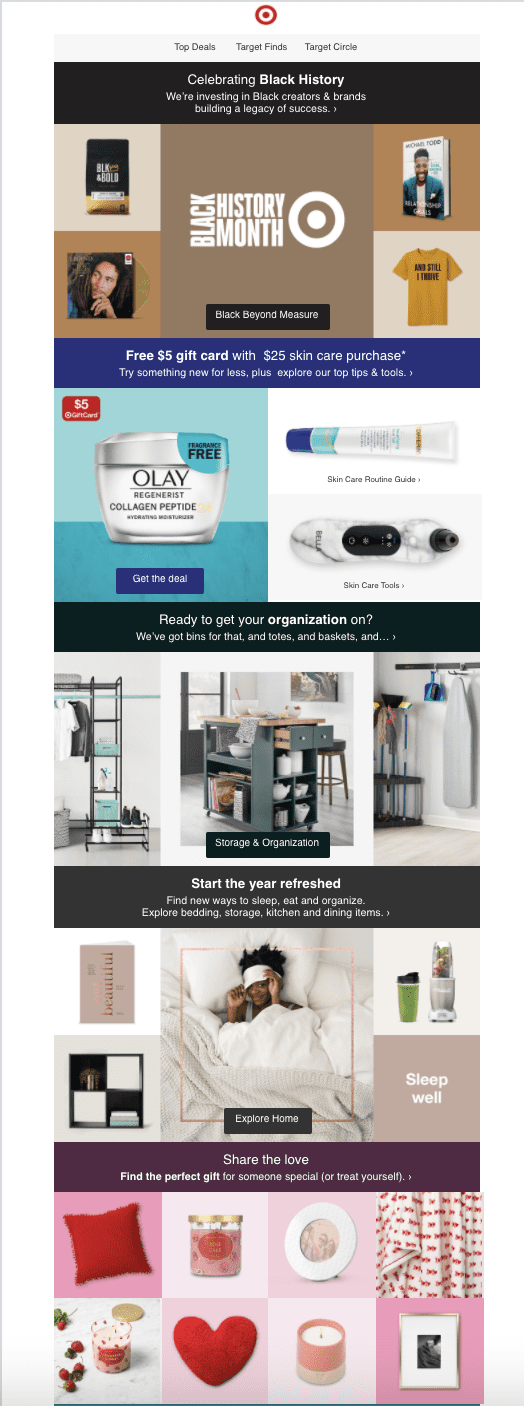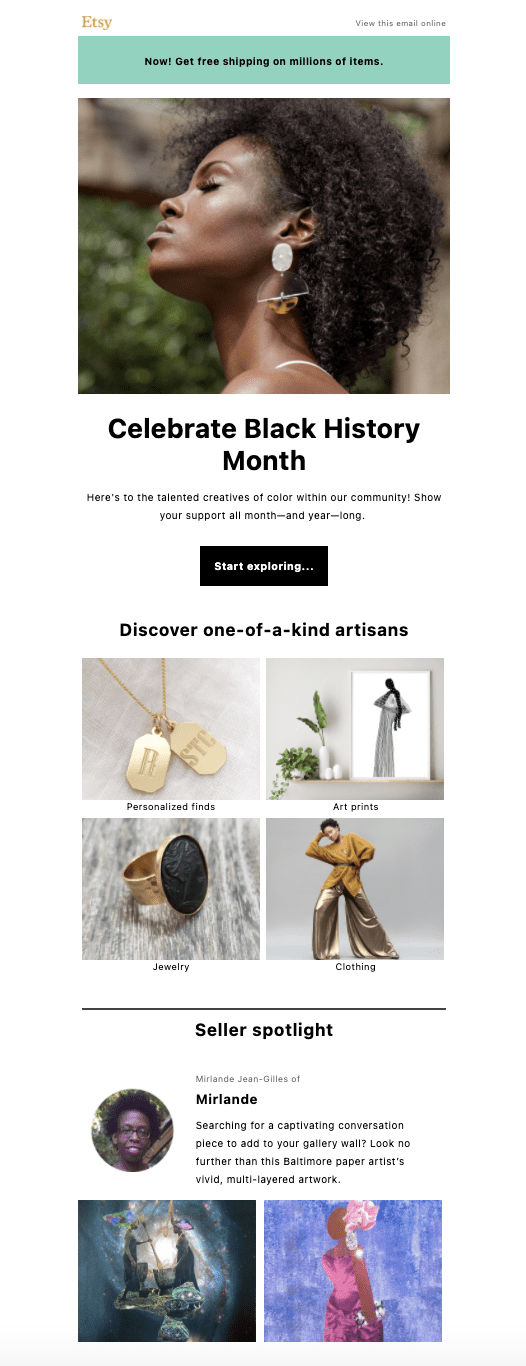Does your email marketing plan include a strategy for Black History Month?
For many brands, this month-long celebration of African American history and achievement has been approached like many other holidays—as a checkmark on the annual, recurring marketing playlist.
But as we know, 2020 was a year of immense—and in some cases, abrupt—change, widely marked by the coronavirus pandemic and the rise of momentum for the Black Lives Matter movement.
The rise in social advocacy (a result of greater awareness from increased mobile use during stay-at-home orders) had a direct impact on a major milestone for Americans: the election of Kamala Harris as Vice President of the United States—the first woman and person of Black and South Asian descent to serve in the position.
These events, and others around the world, have raised the profile of the Black experience worldwide and affected how brands use their marketing messages to show solidarity or affinity with a wider audience.
And this brings us to today’s topic (and a powerful symbol for social justice): Black History Month.
Marketing During Black History Month
Recognizing Black History Month in email campaigns shows your Black customers that you see, value and honor them, especially if you want to expand your customer base to include a more diverse audience.
What do your buyer personas tell you about the racial or ethnic makeup of your customers? What about your company? Although U.S. marketing teams are more diverse than in other countries, they’re still predominantly white.
This move to inclusivity is something consumers are asking for—and acting on—in greater numbers today as more consumers look to do business with brands that align with their values.
A 2019 Google study found 64% of all consumers acted on a brand after seeing an ad they considered diverse or inclusive. The percentages were even higher among specific consumer groups: Latinx+ (85%), Black (79%), Asian/Pacific Islander (79%), LGBTQ (85%), Millennial (77%), and teens (76%).
Another benefit? Black History Month content in a campaign email can also expose other segments of your customer audience to material they might not see in other email campaigns.
With the right intention, and tools, you can launch a Black History Month campaign that resonates with your customers, while helping your brand to win a larger share of a diverse audience.
So where do you start?
3 Tips to Build a Black History Month Campaign
When developing cause-based campaigns, think of them as alliances with the cause—whether it’s Black History Month, International Women’s Day, or support for specific communities, like the LGBTQIA community—rather than events to co-opt for an email campaign.
That means your company should have skin in the game first—a commitment to diversity in recruiting and hiring, monetary contributions to relevant causes, active support through volunteering or direct connections with community advocates and the like—to back up the support your email campaigns express.
Otherwise, your campaigns can venture perilously close to performative allyship—in which a person or company publicly espouses values to look good without backing them up in private.
The ideas and email examples that follow can help you do the groundwork ahead of time to create the conditions that lead to a successful alliance with Black History Month.
1. Collaborate with your employees and customer community
Reach out within your own ranks. Begin with your Black team members and employee resource groups and ask them for content ideas and advice. Seek out members of your user groups or look for influencers in your social media circles whom you could introduce to your wider audience via email.
Michaels, the U.S.-based arts and crafts retailer, featured African American designers on its creative staff and crafters from its social media community in a recent email campaign centered on Black History Month.
“A major part of avoiding missteps is being authentic in anything you do,” Davette Angelo, a Michaels merchandising product manager, told U.S. News and World Report in describing how the retailer tapped its company-wide employee resource group to build a collection of products related to Black History Month. According to Angelo, he and designer Sharae Averhart “pulled on our experiences and backgrounds to put this collection together.”
2. Turn your community into the hero of your story
Does your company support causes, charities or initiatives that benefit racial justice groups? Talk about those in your email content, but put the spotlight on the people who run the communities before mentioning your contributions.
3. Make Black History Month the jumping-off point for permanent change
The always-on nature of marketing makes it easy to move from one campaign theme to the next. Don’t go back to business as usual when the calendar flips over to March 1. Incorporate your Black History Month campaign work into your messaging all year long, and use it to drive corporate change if needed:
- Continue to choose images that represent as wide a range of your customers as possible for all of your campaigns and including diverse viewpoints in content.
- Maintain the conversations you started about diversity and inclusion.
- Commit time, money and effort to diversifying your marketing team and respecting multiple viewpoints.
If it sounds as if your work to create authentic email messaging for Black History Month will end up transforming your marketing program, you’ll likely have to forge new alliances in areas you don’t control. But this work is necessary to include the points of view of people of color and to create authentic messages that appeal to the audiences you want to attract.
Email Examples
Target stands out among big-box retailers for its “Black Beyond Measure” commitment to support Black-owned businesses and diversity of models in age, gender, size and ethnic heritage across its advertising across channels.
The email below is an example of how Target weaves its Black History Month message into regular promotions throughout February.


Target emails regularly feature a diverse selection of models all year long, but the company focuses on its Black Beyond Measure program during Black History Month. Image via MailCharts.
Etsy, the online arts and crafts marketplace, spotlights African American makers and their creations as part of its Black History Month celebration.


Image via MailCharts
If your company isn’t in a position to do a full Black History Month alliance, you can still promote visibility and inclusion with your images, as Saks Fifth Avenue does with its Valentine’s Day promotion below.


Image via MailCharts
Michaels’ Black History Month email campaign combines multiple elements into a compelling call for diversity in the maker community, including a commitment to earmark proceeds from its special collection to a fund for racial equity, spotlights on employees who created the products and images from social media influencers in its user community.


The images in Michaels’ emails generally focus on the products rather than the people who use them, but when they do feature models or influencers, the company includes a wide range of makers. Image via MailCharts.
To be successful with your Black History Month campaigns, you need a goal, a strategy and the right execution. Beyond merely driving sales, your initiative can work to help you connect with segments of your audience that your company might be inadvertently underserving or reach out to a new market group that had not previously been included in your buyer personas.
You also can begin to affect real change within your company to diversify your workplace, bring in fresh perspectives and create more effective messaging. These changes will find their way into your marketing messages all year long, something that will be essential to retaining the customers who were attracted by your initial Black History Month content.
Dear Brands
Now that we’ve seen some amazing examples of brands taking this messaging home in an authentic way, an important question remains: what should we do now?
First, educate yourself. Sure, you’ve been inspired by some incredible examples of inclusive marketing, but before diving into the execution of your Black History Month marketing, make sure you know the history of the month. The Association for the Study of African American Life and History (ASALHⓇ) can be a great place to start.
Next, create. Design your campaigns in a way that spotlights Black customers, empowers Black community members, and signals your brands’ social awareness and support. Marketing is a powerful tool with which to communicate solidarity.
And, finally, pause. As with all things in marketing, approach your Black History Month campaigns with authenticity and intention. Avoid highlighting Black people in your campaigns if you have not showcased your diversity year-round. That being said, if your brand is committed to advocacy around the clock, Black History Month is a great time to highlight your dedication.
So, Should You Focus a Campaign on Black History Month?
Yes! If your company is committed to shedding light on the Black experience and empowering the Black community outside of February, you should be planning a Black History Month campaign. What better way to magnify your message than during a month of celebration?
But remember, answering this question is tricky because recognizing Black History Month isn’t like adding shamrocks to a St. Patrick’s Day campaign email. It touches on issues of race, identity, community and authenticity.
As marketers, we know that connecting with customers takes time and resources. But we commit to this challenge—to finding out who they are, how they see the world, what they value, what they want to hear—because that’s how we grow! By prioritizing inclusivity, equity and diversity, the campaigns you build will be more authentic, informed and, ultimately, successful.































